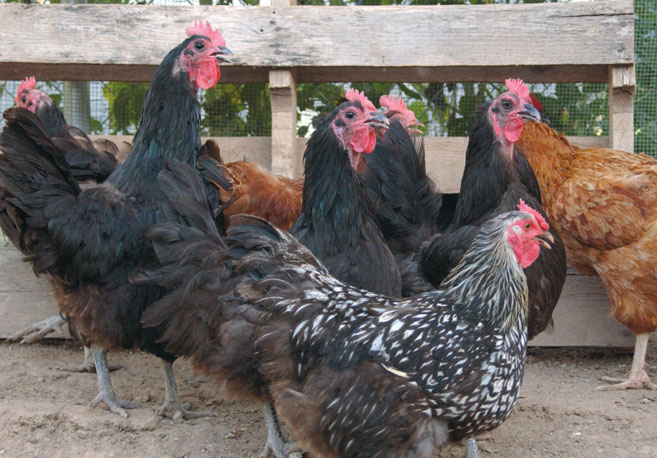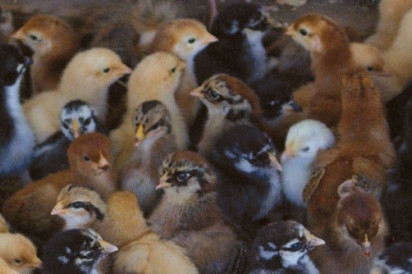Fowl Play: Raise Chickens In Your Yard
Chickens…I believe that everyone who has even a postage-stamp-sized yard can raise them. Yes, you heard me right: Hens are easy to keep and quieter than your average neighborhood dog.
I am often asked why I keep chickens and my litany goes like this: I enjoy harvesting fresh eggs most days of the year, although when it gets very cold or really hot, as it can here in Phoenix, the laying slows way down. Chickens are great soil tillers (rivaling most dogs for how well they dig); they eat weeds, seeds and bugs; and they provide rich fertilizer along the way. Plus they are great natural composters. I push all my food and yard scraps into the chicken yard and let them do their thing. Then twice a year I rake up the leftovers and put them in the compost bins that I keep in the chicken area. That way the hens are doing most of the work.
But I am getting ahead of myself. For several years before I actually acquired my first hen, the mysteries of keeping chickens kept me from taking the leap. After all, I live in the heart of the fifth largest city in the United States and I wondered: How can I keep chickens? What do they eat? When do they eat? Where do they live?
Then quite a few years ago I went to a local business. Sitting on the front desk was a sign that said “Fresh Eggs $1 a dozen.”
I had to inquire. “You keep chickens?” I asked.
The woman behind the desk (Debee) said yes and you can too. Debee, affectionately known as the chicken lady, became my source for all poultry information, and over the next year I quizzed her about her feathery friends. Then a mutual friend offered to give me a few full-grown hens and specific advice for keeping them and I was off and running.
The actual keeping of the chickens is easy. First build them a small coop to live in at night, and then make sure that they have daily food and water. Your local feed store will have all the advice, materials and feed you will need.
I started with some adult hens (no roosters because I value my sleep—plus, hey, I don’t want to perturb the neighbors). However, at some point, I really suggest getting yourself some day-old chicks and raising them to adults. That too is easier that you might think.
To raise your own chicks, start with a large dishwasher-size box, and a smaller 10-reams-of-paper-size box. Cut a chick-size hole in the smaller box and place it with the open side facing up in the bigger box. This creates two “rooms” for the chicks to live in. Now get a 25-watt bulb and hang it in the smaller box so the chicks can get warm and/or cool as they need. Add a little bowl for water (make it small, as the chicks can easily drown) and another dish with some high-protein crumble feed. Change the water and add food daily and in a few months the chicks will be ready for your yard.
Once you have adult chickens, transfer them to their permanent home, which can be a stationary chicken coop or a portable coop, called a chicken tractor. Chickens can survive in your yard without a coop and will find places to roost in the trees and shrubs, but they are not protected from predators. They’ll also eat any greens, grass, flowers and plants they can find. Chicken tractors are great because you can move them from bed to bed—letting the chickens clean up the bugs and weeds and fertilize the area, which makes the planting process a whole lot easier once the chickens have moved on.
I decided to select a permanent place in my yard and put up a small 4- by 8-foot coop for the chickens to retire to every evening. Then I created a chicken yard that is 20 feet by 30 feet for them to live in during the day. This is where I feed the chickens, collect their eggs and generally let them socialize.
A frequently asked question is how many eggs does a chicken lay? A hen starts laying eggs at about five to six months. You can tell when they are laying as they have a tendency to squawk like…well, like a chicken laying an egg. The first year or two, given they are not too stressed, they will lay about six eggs per week. Then as they grow older they lay fewer eggs, but the eggs get bigger. Stressors can include heat, cold, a dog close by or anything else that you might think would have them a little on edge. They also stop laying eggs when they are molting. And to completely bust up the urban myth…you don’t need a rooster for the hens to produce eggs.
However, as with all good things, there comes a responsibility with raising chickens. First and foremost, young children should not play with baby chicks and children in general should be supervised around chickens because the chicks are very fragile and easily injured. Both the chicks and full-grown chickens must be protected from dogs, cats and other potential predators, so they need a coop and enclosed area where they can safely roost. But, believe me, it is well worth it. Here’s to spring chicks and happy egg harvesting by fall.
Greg Peterson owns the Urban Farm (http://www.urbanfarm.org), a sustainability showcase home on one-third of an acre in Central Phoenix. The Phoenix Permaculture Guild (PhoenixPermaculture.org) offers classes on Keeping Chickens in Your Yard with a step-by-step plan for building your flock so you don’t go through years of indecision before you get hens like Greg did.
WHEN YOU’RE READY FOR CHICKENS
Choose which kind of chicken you would like to raise. The three basic types are layers, fancy and meat chickens. I only raise laying and fancy hens, as once I adopt a chicken it becomes a pet. Of the good layer breeds, the Rhode Island Red, Barred Rock, Buff Orpingtons and Sex-link all lay a brown egg. The White Leghorn lays a white egg. And most fun of all are the Araucana and Ameraucana breeds, often called Easter Eggers, which lay blue and green eggs.
For chicks and supplies, I like to frequent Western Ranchman in North Phoenix. They carry a nice selection of chicks from October through May of each year. You can find them at 16028 N. 32nd St., Phoenix; 602-992-3410.
You can also visit MyPetChicken.com. They have incredible customer service, a really nice variety of chickens and pictures of all their breeds on their website. They will ship as few as three chicks, and according to Rachel Bess “these gals cater to the backyard chicken owner.” (See RachelsTinyFarm.blogspot.com for her experience with mail-order chicks.)






